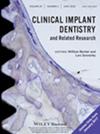Impact of Buccal Bone Arch Contour on Bone Remodeling and Esthetics in Guided Bone Regeneration: A Retrospective Study
Abstract
Objectives
To assess the stability of hard tissue following simultaneous guided bone regeneration (GBR) in the anterior maxilla, analyze the impact of the buccal bone arch contour on postoperative bone remodeling and restorative outcomes.
Methods
Patients who underwent anterior maxillary implantation and simultaneous GBR were included. Radiographic metrics were evaluated using preoperative, immediate postoperative, and follow-up cone beam computer tomography (CBCT) scans, and esthetic indicators were extracted from follow-up clinical records. The buccal bone arch contour of the edentulous area was reconstructed using the mirror symmetry technique. Implants were grouped based on the relative position of the bone grafts and implant to the contour immediately after surgery for comparisons of radiographic and esthetic outcomes.
Results
A total of 66 patients (66 implants) were ultimately included. For simultaneous GBR in the anterior maxilla, a bone gain of approximately 0.55–0.75 units was expected for every additional unit of bone graft. Bone grafts augmented outside the buccal bone arch contour tended to resorb back to the contour, suggesting that excessive bone augmentation may not provide significant benefits. Implants placed more than 3 mm palatally from the contour tended to achieve greater buccal bone wall thickness and more predictable esthetic outcomes.
Conclusions
The buccal bone arch contour provides an individualized reference for determining the appropriate bone graft volume and implant position. Placing the implant at least 2 mm palatally from the contour and augmenting bone grafts to exceed the contour by at least 1 mm appears to be a practical and effective strategy.

 求助内容:
求助内容: 应助结果提醒方式:
应助结果提醒方式:


